When the first diamond frame bicycles became popular in the 1890s they were often called "wheels" - the national cycling association was called the "League of American Wheelmen." We have moved from "wheels" to "bikes," but the bicycles have remained remarkably the same over more than 100 years - elegant in their efficiency and simplicity. And many of the issues that we think are new? They were around then too.
Sunday, July 31, 2011
Is Cycling Safe? The Product Development View
In the Seattle area, supposedly a very bike friendly region, two middle-aged cyclists were recently killed within a period of less than two weeks, one by a truck that went onto the shoulder where the cyclist was riding and another when an SUV made a left turn once oncoming car traffic had cleared, but not the oncoming cyclist. (In the second case, the driver got out, ascertained there was an accident, then drove away - hit and run.) Even though I read about cyclists getting killed all the time, for some reason these two events bother me.
At a conference recently (that had nothing to do with cycling) I heard a presentation by someone from Kickstarter, an organization (well, it's a commmercial company, actually) that provides a vehicle for getting start-up funding for various kinds of endeavors through their web site. Many are small cultural projects but others are efforts to start sales of products of one sort or another.
As it happens, Mr. Bikesnob NYC had a recent blog entry about a Kickstarter project for a bike turn signal system that is built into a left cycling glove. Kickstarter seeks solicitation primarily through videos; the "you turn" fundraiser video is below.
Mr. Bikesnob has lots of fun spoofing this Kickstarter video in various ways, although he leaves aside the main question I had (at first) which is whether the fellow is serious - the circuitry in the glove detects whether the cyclist points his hand up (for a right turn) or out to the left (for a left turn) and activates one of two LED arrows built into the glove. Yes, but . . . we inherited the "left hand straight up = right turn" thing from people driving cars (from when turn signals for cars were not always present!) and most cyclists now use their right arms to signal right turns. Since the left brake lever is for the front brake (also known as the brake that works best) I never signal right turns with my left hand - common sense dictates using my right hand to signal, stuck out to the right, and keeping my left hand on that brake lever. So if you wanted LED turn signals combined with gloves, it would be simplest to put a single arrow on each glove - assuming you think it makes sense to have such digital signals at all.
But I digress.
The real question I have is whether attempts to buttress cyclists' safety through developing new products to buy and use is a good approach. That it is an American approach, that much is obvious, but is it going to make it safer for cyclists?
Frankly I'm doubtful. The two things I believe that are needed to improve the safety of people on bicycles (vis a vis cars, trucks, etc.) is more people on bicycles, which inevitably leads to a lower accident rate for the cyclists; and, in tandem with that, a change in our transportation culture such that the "complete streets" concept makes sense to more and more people.
Of course, common sense says that cyclists are safer when they are visible to motorists if they use roads. (And of course there are laws requiring reflectors, lights, etc. for certain conditions.) This product, however, seems to contribute more to making cyclists more car-like, which doesn't seem particularly helpful. An LED turn signal system for bicycles contributes mostly to making cycling seem more dangerous and more complicated than it should be. The more safety equipment we pile onto cyclists, the less appealing it becomes, thus defeating the "more cyclists = fewer accidents" strategy.
Kickstarter has another cycling funding project - a bicycle brake light system.
It is suggested that having a brake light like a car's (that comes on when the brakes are applied) "has the potential to save many lives." As with the glove-signal system, it seems more to add to the complexity of cycling and to the impression that it is dangerous. Having a light or lights and a reflector to make a cyclist visible when it is dark and to take other measures to increase one's visibility to motorists makes good common sense but "I failed to realize the bicycle was stopping and therefore ran into it" isn't the problem I read about with cyclists hit by cars from the rear, it's the "I wasn't expecting a cyclist at that location, I didn't see him/her, and . . . " situations that are the problem. As the number of cyclists increases, the motorists get used to them, and expect to interact with them in their daily drives (and stop running into them so much). Also, eventually (a la Amsterdam) more and more drivers will be sometimes-cyclists, which can only help.
Now I'll get off my soapbox, such as it is. I'll put forth my thinking on bicycle helmets another time . . .
PS I asked a fellow from the Netherlands recently if he commuted by bike to work on Capitol Hill - his answer? "No, so many here talk about friends they know who got killed riding their bikes. No one in the Netherlands is ever killed riding their bike! It seems too dangerous."
Saturday, July 30, 2011
Ideas for Bicycle Saddles (1896)
One quickly realizes that then as now, there is a sense that there must be a better bicycle saddle. The following examples are all from 1896 ~
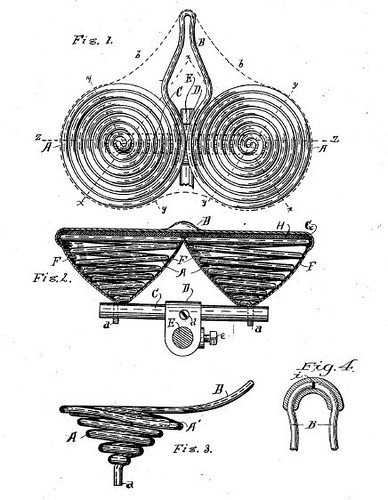
Patent number 554,337
The notion in the above "invention" is that really you just want to sit on a couple of springs.
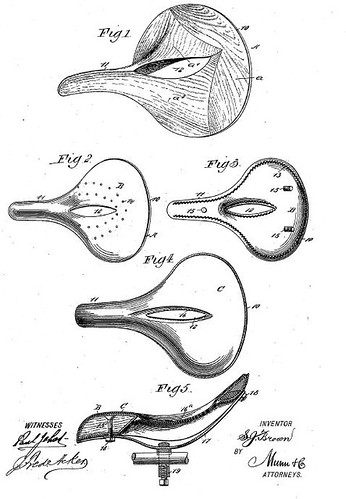
Patent number 556,250
Above is something like the opposite view to the previous patent - no, what you really want to do is sit on a shaped piece of wood! Oh, with a slit in the middle.
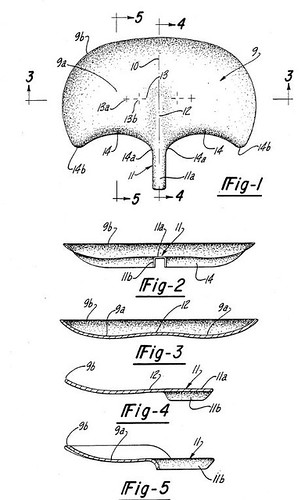
Patent number 557,238
Above, the well-known view even today (perhaps even more so today) that a wider base of support is key.
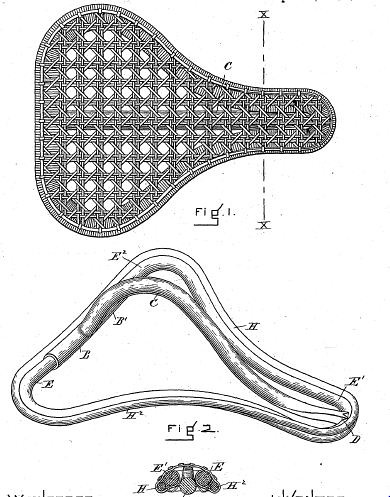
Patent number 558,917
A rather complex contoured approach . . .
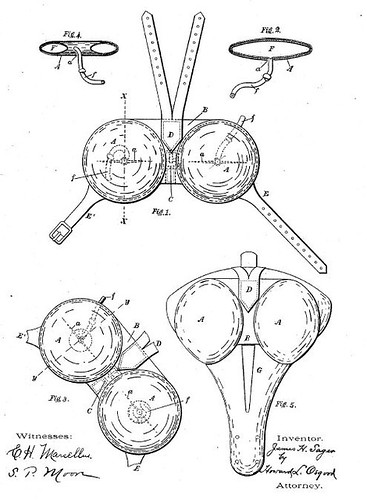
Patent number 562,919
The last example here (but hardly the last patent application for bicycle saddles from 1896) is an "add on" to an existing saddle the would provide inflatable cushions held in place by their invention.
Wednesday, July 27, 2011
Bicycle "Body Shield" (Patent, 1896)
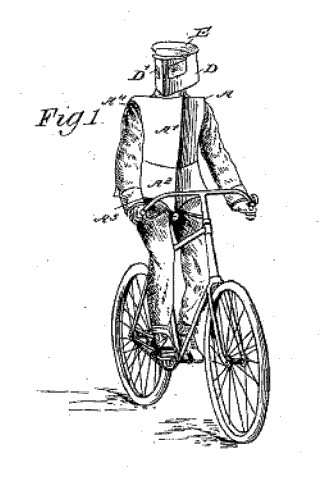
Has every crazy idea been patented?
The object of the invention is to provide a new and improved body-shield more especially designed for use by bicyclists,boatmen, or other persons exposed to the force of the wind, the shield being arranged to not only break the force of the wind against the body of a bicycle-rider, but also to protect the throat, breast, face, and ears of the rider and at the same time permit the rider to easily get on or off the bicycle.
Tuesday, July 26, 2011
Pleasing 1896 Overman Bicycle Poster
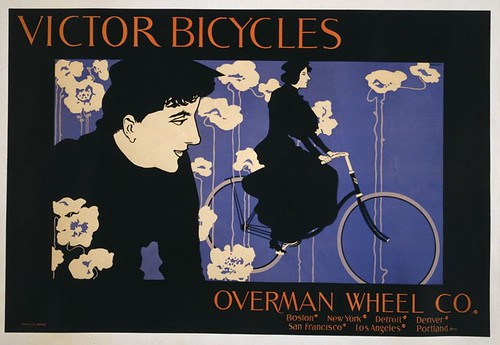
Victor Bicycles, Overman Wheel Co.
Poster advertisement for Overman Wheel Company's Victor bicycles, showing a woman watching another woman riding a bicycle. Includes art nouveau style flowers.
From the Library of Congress.
Monday, July 25, 2011
Plastic Bike Design
None of the comments seem to have been made by anyone who knows much about bicycle design.
The first thing I see is that the steering tube is quite upright, which might be fine for a racing bike but for something like this, it would make it twitchy and requiring more attention to control. It doesn't help that the handlebars are so short.
Can this really not have any metal in it? It would be pretty amazing if you could have crank arms (that connect the drive system to the pedals) that are just made out of plastic that would support an adults weight and transfer power reliably.
It appears that the pedals are relatively spread apart - usually there isn't much variance in the distance left and right of center that the pedals are. A larger distance ("Q factor") is apparently less efficient.
Is the height of the seat adjustable? Doesn't seem like it. That's probably the biggest problem.
Sunday, July 24, 2011
Park Service "Waters" Bikers, Joggers

The roadway is wet, the bikers and joggers are wet
The National Park Service runs a pipe along the roadway of Hains Point and uses pumps to pull river water into a large scale sprinkler system - in their effort to water both sides of the roadway, they blast the water across the roadway, too. From time to time one gets a blast in the face - it's a little strange. Since it's hot, it has its positive aspects, but on balance I would rather not have this experience too often.

Putting his head down to avoid getting a direct blast from a sprinkler
Generally I'm pretty comfortable for anything under 30-40 miles on my road bike, but apparently due to an unusual amount of squirming as I tried to avoid the sprinklers, after a lap or so I wasn't and this was only a 25 mile ride.
The Park Service puts up a sign that notes that the river water is not potable - so we won't try to drink from the sprinklers, I guess. But is it suitable for showering?
Of course, if they feel that the grass on Hains Point needs to be green, I guess it makes sense to use the river water.
Thursday, July 21, 2011
Best Bike Parking - for Some
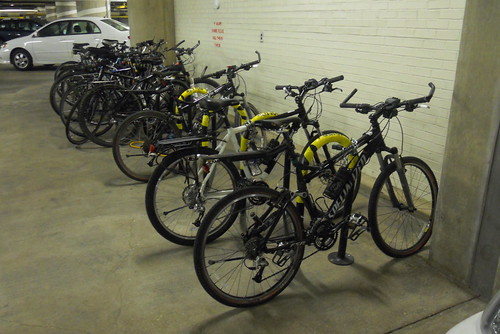
Four spots set aside for three police bikes
In my office building on Capitol Hill, we are protected by federal police. This parking lot has 24 slots for bicycle parking, half in the center and half at one end of the garage. Through some sort of unspoken tradition, the bicycle commuters know who parks where. This has been upset by the police taking four of the 12 spots near the center in order (at least for now) to park three bikes. (One of the bikes is made by "Smith & Wesson" - well known for making bikes! Stop or I'll shoot you with my bike!) This has completely upset the bicycle commuter ecology right in the middle of the prime riding season. (Well, ok with the heat wave, maybe not entirely prime in the usual sense.) So the police have three bikes on the four closest most convenient slots and the staff who are bike commuters have crammed ten, eleven, etc bikes into eight slots to see how much paint they can scrape off each others' bikes.
These police bikes are locked up with the most absurd chains and padlocks - you would think they were locking them up in some high crime area and not in a garage guarded like a fort.
PS - I thought perhaps this gift of parking places to the police might put us out of compliance with the DC "for every ten spots for cars, one for bikes" law but they count the slots on bike racks in front of the building. 95 percent of the car parking is in a garage and 75 percent of the bike parking is outdoors. Oh well.
Monday, July 18, 2011
Cyclist-Diplomat Endorses U.S. Tobacco (1917)
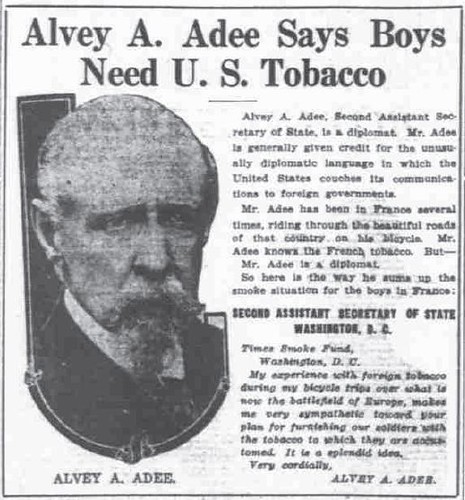
This seems to be an endorsement of a way that The Times supported the war effort (during World War I)
Alvey A. Adee Says Boys Need U. S. Tobacco
Alvey A. Adee, Second Assistant Secretary of State, is a diplomat. Mr. Adee is generally given credit for the unusually diplomatic language in which the United States couches its communications to foreign governments. Mr. Adee has been in France several times, riding through the beautiful roads of that country, on his bicycle. Mr. Adee knows the French tobacco. But -- Mr. Adee is a diplomat.
So here is is how he sums up the smoke situation for the boys in France:
Times Smoke Fund,
Washington, D. C.
My experience with foreign tobacco during my bicycle trips over what is now the Battlefield of Europe, makes me very sympathetic to your plans for furnishing our soldiers with the tobacco to which they are accustomed. It is a very splendid idea. Very cordially,
Alvey A. Adee
Sunday, July 17, 2011
Nice Steel Track Bikes for a Sunday
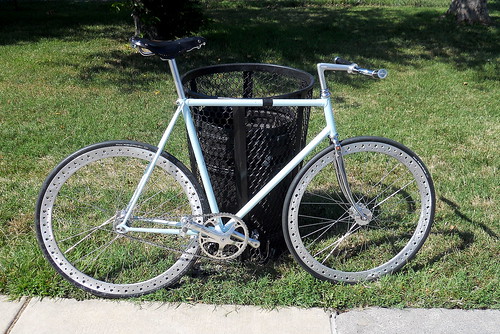
Old school drilled holes in rims to lighten - and enhance appearance

French 1960s Abel Borne track bike - weighs only 13 pounds
Steel is real! But can be light.
Fellow said this was one of only 26 such track bikes produced.
Saturday, July 16, 2011
Diplomats Need Cycling Exercise (1912)
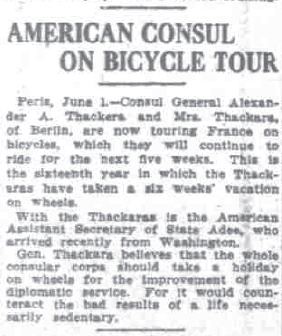
From the society page of the paper
Gen. Thackary believes that the whole consular corps should take a holiday on wheels for the improvement of the diplomatic service. For it would counteract the bad results of a life necessarily sedentary.
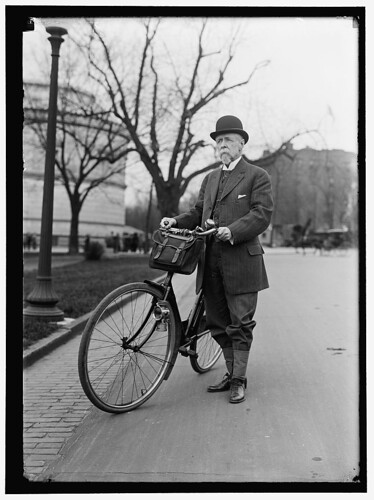
Alvey Adee at age 72 and his bike in Washington, 1914
Photo from the Library of Congress
More information about Adee.
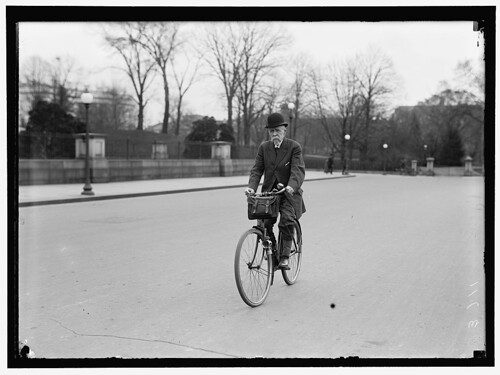
Adee riding in Washington
Photo from the Library of Congress
Description of Adee's diplomatic career in "Washington close-ups" By Edward George Lowery, 1921.
Tuesday, July 12, 2011
Unusual Bike Commuter Hazard - a Black Bear

Something that might be more frightening than an angry motorist
Monday, July 11, 2011
Police Ticketing Sunday Bikers, Haines Point
View Larger Map
Sunday morning at 9 am I took off to Haines Point in Washington DC to do some laps of the trianguler peninsula along the Potomac River. I have seen U.S. Park Police writing tickets at this same location, the junction of Buckeye Drive and Ohio Drive, before on a weekday afternoon but not on a weekend. Anyway, every time I went past on my laps, they had someone different (sometimes groups) stopped. I don't know if they were giving tickets or just warnings, but I suspect they were writing at least some tickets. It can be a $50 ticket if they write one. On my last time through, a bit after 10 am, there were two Park Police vehicles parked up on the median strip in plain sight and they were still pulling cyclists over.
Sunday, July 10, 2011
Weight of Cycles (1890s' View)
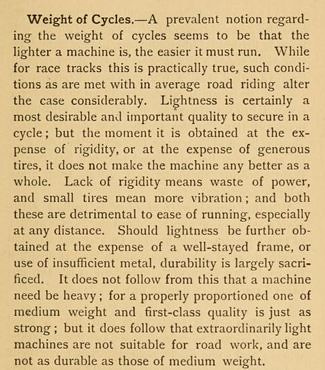
A discussion of the all-important bicycle weight question
A prevalent notion regarding the weight of cycles seems to be that the lighter a machine is, the easier it must run. While for race tracks this is practically true, such conditions as are met with in average road riding alter the case considerably. Lightness is certainly a most desirable and important quality to secure in a cycle; but the moment it is obtained at the expense of rigidity, or at the expense of generous tires, it does not make the machine any better as a whole. Lack of rigidity means waste of power, and small tires mean more vibration; and both these are detrimental to ease of running, especially at any distance. Should lightness be further obtained at the expense of a well-stayed frame, or use of insufficient metal, durability is largely sacrificed. It does not follow from this that a machine need be heavy; for a properly proportioned one of medium weight and first-class quality is just as strong; but it does follow that extraordinarily light machines are not suitable for road work, and are not as durable as those of medium weight.A reasonable point of view! The author goes on to offer further analysis~
Since 1892 the advance that has been made in building light bicycles has been absolutely extraordinary, and in less than three years the weight of road machines has been reduced from forty-five to twenty-two or twenty-three pounds. No man, however heavy, need ride a modern wheel of over thirty pounds' weight; very few need ride over twenty-five pound wheels, while the majority of good riders can be safely fitted with wheels that weigh but twenty-two or twenty-three pounds. Of course a good many wheels at even less weight than this will be used on the road, but it should be done with extreme caution. Track racers run from fifteen to eighteen pounds.A modern carbon fiber racing bike that weighed around fifteen pounds would be a costly item, but the track bike described for the 1890s would not have any gears or brakes, which do add weight even on a modern bike. And to save weight, the wheels of an 1890s track bike might well have been made of wood.
Still, one wonders at how quickly steel cycle builders of the 19th century managed to make lightweight track cycles that rival those of a hundred years later in certain measures.

Typical single speed cycle from 1897
Friday, July 8, 2011
More Accurate Video of Dutch Cyclists
The speeded-up version of Dutch commuters that received so much attention
The speeded up version does reduce the "boredom factor" and makes it clear more quickly how many cyclists are moving to and fro in such a business-like way.
Now however the blogger has released a real-time version, which I think makes the same points just as nicely.
Real-time video of same intersection
At about 45 seconds, a father (presumably) takes off from a stop with his son on a bike to his right (and daughter riding in a seat and behind him), putting his hand on his back to help get him up to speed. Don't see much of that here.
The mix of bikes is interesting, too, and easier to observe at the slower speed. Bikes in the Netherlands are obviously more about urban transportation and (much)less about sport - I saw only one or two drop handle road bikes among all these. Of course, part of that may well be that cycles are required to have a headlight and tail light and most of these bikes, used daily, have fenders (with the tail light built into the rear fender).
I find it interesting how practically everyone seems to be following the rules (or laws, I suppose). There are the occasional riders who don't stop for the light, but they are very few. And of course the sheer volume, even in real-time, makes an impression compared to the Washington DC area. Even in real time, the left turns by some of the cyclists seem almost choreographed. Of course, the real-time version takes five minutes and the speeded-up version takes only two. . .
Monday, July 4, 2011
Rights of Cyclists on the Road (1895)
Rights of Cyclists on the Road. — The right of the cycle on the road is the same as that of other vehicles, — neither more nor less, — and is so held by the courts. Wheelmen have, in some places, been put to considerable labor and expense to establish this fact; but have done so with uniform success, chiefly through the efforts of the League. Of course, when the cycle makes its first appearance in new regions, the blind conservatism which seems to be inherent in human nature is apt to breed prejudice against it; but moderation and experience, with firm prosecution of any case of infringement of rights, will soon put things on a right basis.
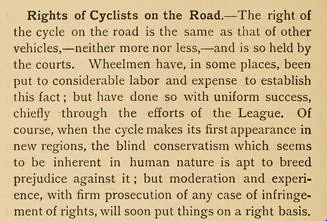
The more things change, the more they stay the same
Keeping in mind that this was before there were cars on these "highways" mentioned, it goes on to say:
In many localities wheelmen have been accorded advantages much in excess of their rights. They have been granted the privilege of using side paths and even paved walks; no objection has been made to their coasting on crowded hills, and forcing other vehicles from their track; and they have been permitted to ride at racing speed, even on crowded highways. Such concessions have had the effect of making many wheelmen very careless of the rights of pedestrians, and of those of drivers of wagons and carriages, while asserting their own rights and privileges to the full. By so doing they have intensified the prejudice already existing in some quarters against the sport, and have aroused the prejudice of others whose rights have been infringed by being rudely driven from their path, or portion of the road, by the necessity of giving ample space to some reckless rider. It is not only bad form and worse manners to act in this way, but it is most wretched policy, for it injures the whole body of wheelmen in the eyes of the public.In summary, cyclists have equal rights, but they should behave reasonably towards others. And if they have been accorded special rights, courtesy is to be expected.
Where roads are bad and wheelmen are permitted to use side paths, they ought to reciprocate the privilege accorded them by extending every possible courtesy to pedestrians, never warning them off the path by bell or whistle, but rather, by riding slowly and requesting the pedestrians to kindly allow their passage, and thanking them when they have done so. There are many cyclists who are thoughtless in these matters, and there are others who pretend to believe that it is pusillanimous to extend such courtesies ; but they ought to remember that they are on a path only by courtesy, and are bound, in common decency, to return that courtesy.
Sunday, July 3, 2011
An 1890s View On Safety

Title page of the popular 1890s book, "Cycling for Health and Pleasure
The view on crashes between two bikes would probably not meet with the approval of modern litigators. From page 67 of Cycling for Health and Pleasure, published in 1895:
Riders ought to observe all the rules of the road, and not court disaster or engender ill feeling by disregarding them. It is very common for a number of wheelmen to divide, both on meeting and passing vehicles, and in so doing increase the chance of frightening horses, and make collisions far more probable. In the case of collision between two bicycles, it should be remembered that the aggressor will receive the less damage if the machines are of equal strength, so that if a collision is actually unavoidable, it is worth while to become the aggressor if possible, or at least to endeavor to give as much shock as you receive.

"Cycling for Health and Pleasure" was apparently popular - the Library of Congress has editions from 1890, 1895 and 1896. The 1890 version was published by the small "Wheelman Press" while the later editions were published by the large commercial publisher Mead, Dodd.
Saturday, July 2, 2011
Wheels & Bikes at Shirlington

Bike rack in front of the Shirlington public library
So, why the locked up "extra" wheels at this bike rack? How did this happen? (These photos taken early Saturday morning before they are obscured by other parked bikes.)
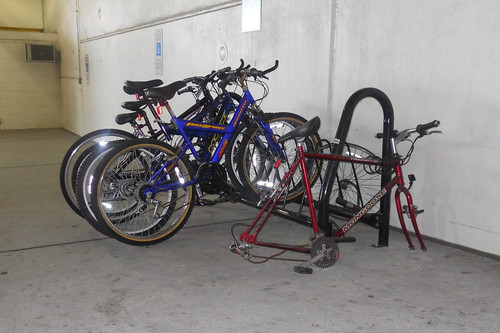
Bike rack in the Harris Teeter parking garage at Shirlington
100 yards/meters or so away, we have this sad Mongoose that has lost its wheels - perhaps they are locked in front of the library!